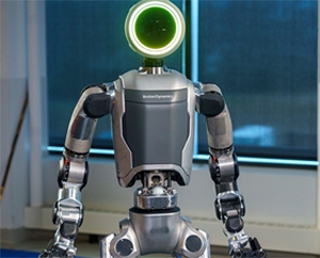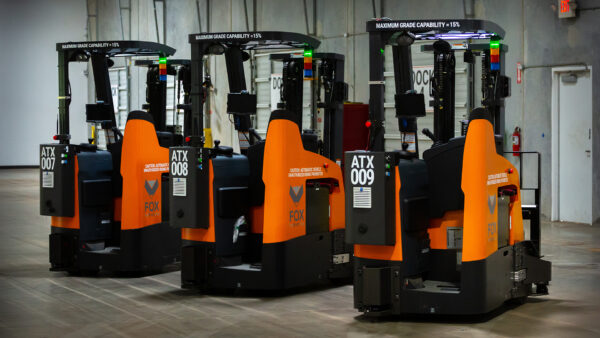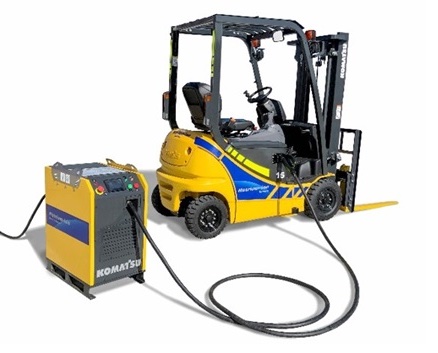 Humanoids have made an entry in materials handling
Humanoids have made an entry in materials handlingThe year 2024 will go down in the history books of the materials handling sector as one of innovation, increased automation and striving for clean fuel sources with huge investments in R&D announced by some big players as the drive towards electrification and digitisation appears unstoppable.
Frank van Dijck, president of FEM European Materials Handling Federation, tells Forkliftaction News in 2024 the sector enjoyed “significant advancements in digitisation, AI, robotics and sustainability.”
“The integration of AI and machine learning has enhanced predictive maintenance and operational efficiency, while autonomous mobile robots (AMRs) and autonomous vehicles (AVs) have revolutionised warehouse automation, leading to increased productivity and reduced labour costs,” he continues.
 Frank van Dijck
Frank van Dijck
“Our industry is rethinking its operations and the solutions it offers in order to reduce energy consumption and carbon footprint, and to foster a circular approach.
“These developments have collectively contributed to a more efficient, sustainable, and technologically advanced materials handling landscape.”
Matt Barber, director of membership at LEEA (Lifting Equipment Engineers Association) concurs saying 2024 will rank among “the biggest leaps forward in the lifting industry,” in part because of digitalisation.
“Throughout 2024 we witnessed the continued march of digitalisation across many aspects of lifting, with technology innovating everything from equipment to training and administration,” he continues, adding technology is now “integral to all aspects of our everyday operations including our training.”
Leigh Lytle, president and CEO of the Equipment Leasing & Finance Association (ELFA), representing financial services companies in the US equipment finance sector, adds that despite the “worst inflationary shock in almost four decades and a surge in borrowing costs,” demand for equipment finance remained strong throughout the year.
The rise of robots and automation
It was a year with plenty of new automation and robotic products launched for the materials handling sector as well as some very significant investments announced.
Products
In February, Toyota Material Handling Europe teamed up with Croatian technology company Gideon to develop software for autonomous mobile robots (AMRs). In the same month in the United States, integrated logistics company ArcBest unveiled its new autonomous materials handling technology which combines AMRs and remote teleoperation capabilities, and RightHand Robotics launched the RightPick 4, its next-generation autonomous robotic piece-picking system for warehouse order fulfilment and distribution centres.
Swiss autonomous navigation leader BlueBotics and Pramac in March introduced their mobile robot solutions under the X-Act brand with three robot models.
In April, Chinese electric vehicle manufacturer BYD added a fleet of ForwardX AMRs and autonomous forklifts to its battery production line. BYD's ForwardX fleet is made up of nine Max 1500-L Slim AMRs and six Apex 2000 autonomous forklifts.
 The FoxBot autonomous forklift
The FoxBot autonomous forklift
KION North America announced in May it would start manufacturing and assembling FoxBot autonomous forklifts (ATLs) designed for load/unload operations on warehouse loading docks, while Chinese forklift-maker Hangcha broke ground on a new USD140 million factory that will produce 10,000 units of automation equipment a year and is expected to be operational by the end of 2025.
Still in May, Singaporean warehouse automation company XSquare Technologies raised USD7.8 million for product development and regional expansion. XSquare Technologies is partnering with Mitsubishi Logisnext to collaborate on the development of a new line of AGVs.
The month of June saw German order picking systems manufacturer Bito unveil its new generation of LEO AGVs, and in July, Doosan Robotics Americas announced it will integrate Rocketfarm’s palletising software into its collaborative robots (cobots) under a new strategic partnership.
In August GreyOrange unveiled two new autonomous forklift models capable of handling closed pallets and managing multiple pallets or trolleys concurrently.
At the end of October in the US, automation specialists Vecna Robotics launched CaseFlow, a system which uses pallet-handling robots “for up to 90% of warehouse travel” using direct zone picking, while in the UK, Rainbow Robotics launched its RackBot automated picking solution.
In November, AMR solutions manufacturer Seegrid Corporation announced it will no longer be a distributor for US-headquartered materials handling equipment producer Raymond Corporation. A week later the company announced it is joining the Open Source Robotics Alliance (OSRA) where it will “actively support initiatives that foster collaboration and shared knowledge across the robotics field.”
Automation providers expanding markets
Reaching out to new regional markets was on the agenda for many providers of automation solutions. Danish robot maker Robotize, Belgian automated warehouse solution provider Movu Robotics, Spanish industrial robotic company Kivnon and Japanese robot maker LexxPluss all signed agreements that see them distribute their products into the American market. While the French autonomous mobile robot (AMR) maker Effidence continues its expansion in Asia through Hong Kong-based distributor Delta Pyramax.
Humanoids in materials handing
This year also saw the first appearance of humanoids in the materials handling space.
In March, Amazon founder billionaire Jeff Bezos and Microsoft were among the big names to invest in robotics company Figure, which is developing humanoid robots. The funding will be used to accelerate the introduction of its humanoid robots to market.
In May, America’s Zion Solutions Group became the first systems integrator to offer a humanoid robotic solution to the supply chain industry through a partnership with bipedal robot Digit creator Agility Robotics.
Five months later in October, Agility Robotics entered a partnership with warehouse design and automation solutions specialists Tompkins Solutions which will see Digit integrated into Tompkins Solutions service offerings, bringing advanced robotic solutions to warehouse operations.
Still in October and a new research agreement aimed at accelerating the development of general purpose humanoid robots, was announced between Toyota Research Institute (TRI) and Boston Dynamics.
TRI is the AI and automation R&D arm of Toyota Motor Corporation while Boston Dynamics was acquired by Hyundai Motor Group in 2020 and deploys highly mobile robots within a number of sectors including the warehouse-specific robot Stretch. The research partnership will integrate TRI’s large behaviour models with Boston Dynamics electric humanoid robot Atlas.
Adoption of automation in intralogistics
As expected, large-scale automation starts with big companies and throughout the year we reported on some of the remarkable investments in the adoption of autonomous equipment.
In Australia, Caterpillar equipment dealer WesTrac in February deployed a team of robots, including Cata-picker, Wall-E and Bumblebee, at its new distribution centre in News South Wales and, a month later, book retailer Booktopia deployed a fleet of Locus Robotics’ AMRs in its Sydney fulfilment centre.
In May Holman Logistics added a fleet of autonomous high-reach forklifts from Third Wave Automation to its multi-client warehouse in Spanaway, Washington.
In August, a Reuters report announced American retail giant Walmart plans to invest USD200 million on autonomous forklifts, rolling out the move in stages over several years. Walmart had previously announced in April the rollout of 19 autonomous forklifts at four of its distribution centres after a 16-month trial of FoxBot autonomous forklifts.
After a nine-month trial of remote-controlled forklifts at a logistics site in Germany, international logistics service provider DB Schenker, in November signed a Letter of Intent to “scale the technology”, developed by German software company enabl Technologies, to more of its locations globally.
Automated storage and retrieval systems (AS/RS)
Automation drastically changed the logistics sector in 2024 with automated storage and retrieval systems (AS/RS) increasing speed and efficiency of the transportation and storage of goods between manufacturer and consumers. Tight competition will no doubt see this development continue to grow in coming years.
The year started with Canadian transport and logistics company GoBolt in January announcing it would integrate Instock’s AS/RS into its nine fulfilment centres in North America.
In April, beverage and snack food giant PepsiCo installed Dematic automation at its production and logistics facility in Rojana, Thailand, including an AS/RS that links both the production and order fulfilment areas of the plant.
In May, ABB Measurement and Analytics added an AS/RS from its parent company to its Lake Como factory in Italy where they say the automation has led to a 90% improvement in overall logistics efficiency at the instrumentation factory.
In July, Irish logistics and distribution company Dixon International Transport opened a 46,000-pallet fully automated warehouse, with chilled and heated storage space, fitted out with Moffat Automation’s Taxi AS/RS.
Still in July and Airbus Helicopters became the first aeronautics company to install an AS/RS with its new logistics hub in Spain. The 50,000 sqm facility is equipped with an automated and robotised storage system from French warehouse automation specialist Exotec.
US auto parts manufacturer Mahle engaged global intralogistics specialists Kardex in August for its automation process, adopting its intelligent goods-to-person AS/RS and robotic cube storage system.
In November, Coca-Cola Europacific Partners announced it is investing GBP42.3m (USD53 million) in a new AS/RS warehouse to be built at its Wakefield site in the United Kingdom.
Electrification and lithium-ion technology
While an appetite for clean fuel sources has been a driving force in the push for innovation around electrification and lithium-ion power sources for materials handling equipment, there is also growing legislative pressure.
In the case of forklift operators, manufacturers and dealers operating in California, they have had cleaner fuel sources forced on them with the California Air Resources Board (CARB) passing legislation mid-year to ban large spark-ignited (LSI) forklifts. From 2026 it will be illegal to produce or sell Class IV and Class V LSI forklifts in the state.
The desire for greener, more eco-friendly operations is also driving the push towards sustainable alternatives to diesel and petrol-powered equipment.
 Ben Newey
Ben Newey
Speaking with Forkliftaction News in July, Hyster-Yale’s vice president of sales and marketing Asia-Pacific, Ben Newey stated: “There is a strong push from customers for energy-efficient equipment and the full electrification of operations, with some aiming for fully green operations as soon as next year.”
Forklift manufacturers continue the electrification process
In 2024 we saw several major forklift brands add more electric models to their range of materials handling equipment to satisfy the appetite and demand for equipment which is powered by more eco-friendly fuel sources.
In February Hyster Company released its power switching system - Hyster’s Power Cellect - which allows users to easily change battery type without any external accessories, software downloads or integrations which will be available as an option on 27 of its electric forklift models.
Yale Lift Truck Technologies in March expanded its budget UX line of forklifts with two new lithium-ion counterbalance forklifts, the three-wheel ERP32-40UXTL and the four-wheeler ERP30-70UXL.
April saw Clark Material Handling unveil a new 2.7 T to 3.2 T indoor-outdoor pneumatic forklifts. The SE25-35 is the latest addition to the S-Series lineup initially launched in 2017 and is powered by a 48 V lead-acid battery or a fully integrated 80 V lithium-ion battery.
At the Intermat trade show in Paris in May, Chinese construction equipment manufacturer LiuGong started the rollout of more than 40 models of electric battery vehicles, including telehandlers and access equipment with the full range expected to be available by 2027.
Konecranes introduced a heavy-duty version of its E-VER electric forklift in June, with a capacity of up to 25 T as it pushes ahead with plans to electrify its entire forklift fleet by the end of 2026.
In July Chinese forklift maker Heli unveiled its G3 Series compact rough terrain forklift at the opening of its new Oceania headquarters in Australia.
Hyster-Yale in August launched a new line of indoor-outdoor Li-ion powered forklifts in the United Kingdom with a lifting capacity of up to 3.5 T. The company says the models in its J2.0-3.5XTLG series deliver performance comparable to internal combustion engine (ICE) forklifts.
In September EP North America launched two new lithium-ion powered forklifts to the North American market. The CPD45F8/50F8 is an IPX4 rated, pneumatic forklift designed for outdoor applications utilises an integrated EP Energy 80V lithium-ion battery and the EFLA251 comes standard with a 80V lithium-ion battery and is a direct alternative to the internal combustion engine powered cushion tyre forklift.
Container terminals electrifying fleets
It was an enormous year for APM Terminals which invested heavily in the electrification process for many of its port and terminal operations. Announcements in 2024 included that the company would: upgrade ports in Croatia and Malaysia with new equipment; spend EUR100 million (USD104.6 million) on electrifying Rijeka Gateway’s container handling equipment fleet and; ordered 240 pieces of new container handling equipment for five of its terminals in Latin America, Africa and Europe.
APM Terminals also installed the first electric reachstackers in Brazil which joins its fleet of 28 all-electric pieces of Sany container handling equipment. The terminal will be the first 100% electric terminal in Latin America and will operational in H2 2026.
Also the Port of Los Angeles invested in electrification in 2024 deploying the first US battery-powered electric cargo top handlers as it strives to become a zero emissions port.
Investments in new power technologies
As the demand for lithium-ion and electric solutions continues to grow, battery makers are investing enormous amounts of time and money into research with new power technology hitting the market regularly.
In January Amazon installed a hydrogen production system capable of powering 400 hydrogen fuel cell-powered forklifts at its fulfilment centre in Colorado.
In February we saw the first deployment of hydrogen fuel cells as a power source in materials handling with a world-first conversion of a rubber-tyred gantry into hydrogen-powered at Japan’s Hanshin Port’s Kobe International Container Terminal.
Also in February a US automaker announced it would use Plug Power’s hydrogen infrastructure and fuel cells at a new electric vehicle manufacturing facility with its entire materials handling fleet - including forklifts and tuggers - to run on Plug Power’s hydrogen fuel cells. Plug Power also completed its 13th hydrogen refuelling station (HRS) in Europe, supporting the conversion of lead acid battery-powered materials handling equipment to hydrogen fuel cell-powered.
 The world's first sodium-ion powered forklift by Komatsu
The world's first sodium-ion powered forklift by Komatsu
March saw Komatsu unveil its forklift powered by sodium-ion batteries and in April EnerSys subsidiary Hawker announced plans to build a USD500 million lithium-ion cell gigafactory in South Carolina as it sought USD200 million in incentives from the South Carolina and Greenville County to help fund the facility. Also in April, Ballard Power Systems announced plans to invest USD110 million in phase one of Ballard Rockwall Giga 1 in Texas.
Hyster continued to feature in the news for its innovations including the prototype of its world-first hydrogen-powered reachstacker arriving at Spain’s Port of Valencia in September for testing in real-world conditions.
A new Lithium-ion battery manufacturing facility with the capacity to make 15,000 lithium-ion battery packs annually, opened in Thailand in November under a joint venture between smart energy solutions provider Banpu Next and Singapore-headquartered energy storage solutions provider Durapower.
Also in November, Doosan Bobcat signed a MoU with South Korea’s Gwangyang City and logistics service company Logis Pool (KLP) to “expand the supply of hydrogen forklifts” to the “hydrogen city.”
Chinese manufacturer Hangcha New Energy Forklift in December announced it had signed an agreement with Beijing Nowogen Technology to collaborate on building and operating a 25T solid-state, hydrogen-powered forklift development project with production of hydrogen-fuelled forklifts slated to begin in H1 2025.
Also in December, BMW Group announced it will transition to hydrogen-powered forklifts and tugger trains for all of its logistics and transport tasks at its Regensburg plant phasing out of electric-fuelled vehicles from 2025.
Artificial intelligence (AI)
Technological change will no doubt be a key highlight for many sectors looking back at 2024 and that is certainly the case for the materials handling industry with artificial intelligence (AI) proving to be a useful tool for improving safety and efficiency.
In April Automation engineering specialist Applied Manufacturing Technologies launched a new robotic system to assist automated storage and retrieval systems (ASRS) using AI to improve the process and a New Zealand fruit packing company installed AI-powered pedestrian detection systems on its 40 forklifts.
In August The field of AI forklift driving analysis holds so much promise, Toyota Material Handling Japan announced it will work with Fujitsu to launch Japan’s first AI forklift driving analysis.
Still in August and Swiss university spinoff, Flink Robotics received funding of USD170,170 to develop plug-and-play robot “workers” which can package, sort and unload goods.
AI is already proving to have practical applications in materials handling, helping to improve a number of processes and safety in the warehouse environment. In September US supply chain AI solutions provider Kargo’s Kargo Lift system, purpose-built for forklifts and AGVs, using AI to automate the shipping and receiving processes while taking data collection beyond the loading dock.
Order picking processes have been a key area of innovation including Italian automation solutions provider Comau unveiling its MI.RA/OnePicker which uses AI to autonomously pick miscellaneous objects from the same bin without relying on CAD-based assistance or prior information.
Also in October Australian digital freight provider Ofload launched a whole-of-supply-chain, AI-enabled platform which allows businesses to measure and optimise its carbon emissions and freight performance.
Mergers and acquisitions
There was plenty of mergers and acquisition activity throughout the year including Kalmar making its debut on the Nasdaq Helsinki following a partial demerger by parent company Cargotec.
In February US-based Taylor Group acquired an 85% stake in CVS Ferrari, makers of JLG telehandlers and Hinowa forklifts while
April saw Konecranes acquire crane and service provider Kocks Kranbau GmbH for an undisclosed sum and then in December shored up its port presence in Rotterdam with the acquisition of Port Services BV and Peinemann Container Handling BV.
In May Manitou Group integrated its South African dealer Dezzo Equipment into its fold while in August rental equipment provider PT Coates Indonesia and PT Coates Services Indonesia were sold by parent company Coates Australia to Mitsubishi Corporation for USD29.6 million.
Still in August and two established US brands in the Pacific North West, Raymond West Intralogistics Solutions and Toyota Lift Northwest, merged to create a new materials handling entity which expects its combined annual revenue to exceed USD1 billion.
Also in August, the merger of south-eastern construction and materials handling equipment rental business Synergy Equipment with Texas-based Opifex Enterprises created the ninth-largest general equipment rental company in the US .
In September Oshkosh acquired Spanish equipment manufacturer Ausa and Swiss-based materials handling solutions provider Interroll Group finalised the acquisition of Interroll India while October saw the Supply Chain & Logistics Association of Australia (SCLAA) announce the strategic acquisition of industry association Supply Chain Partners.
Our most-read stories of 2024
The most-read Forkliftaction News story of the year was about Toyota Industries Corp’s (TICO) admission in February of “emissions cheating” for nine of its forklift models with the Japanese giant further admitting to having sold 230,000 forklifts which had been fitted with non-compliant engines since 2014. Toyota has a healthy 30-plus percentage of the global forklift market and is the world’s largest producer.
“The company understands that this matter has caused a great deal of trouble for our customers, our sales agents, vendors, competent ministries and many other related persons, and the company again apologises for that,” TICO said in a statement at the time.
In September, a proposed class action against Toyota in the United States was filed with the District Court of California.
Crown Equipment Corporation found itself in the news - and was our second most-read story - when it became the victim of a cyber attack by what it described as “an international cybercriminal organisation” in June which halted its production internationally while also impacting its payroll, website and phone system. The company’s systems were offline for two weeks.
What will 2025 hold?
Given the impact of digitisation and the evolution and investment in robotics and automation, it would be a fair bet these will continue to be headline stories through 2025 and beyond, as will what is becoming a relentless pursuit of materials handling practices which are sustainable and eco-friendly.
Frank van Dijck from FEM tells Forkliftaction News technological advancements, including AI, automation and robotics, offer enormous promise and potential for the materials handling sector in 2025, supporting the move to e-commerce demand as well as expansion and innovation.
With ELFA research revealing 42% of equipment and software end-users utilise generative AI in their businesses and an additional 42% indicating they intend to do so over the next two years, this is an area the association will be following closely in the coming year.
 Leigh Lytle
Leigh Lytle
Leigh Lytle from ELFA tells Forkliftaction News that “green finance” is another area of interest with its research further showing “nearly one-third of equipment and software was acquired to support energy-related, climate-related, or other environmental goals and pledges.”
“With global climate finance expected to grow to USD9 trillion by 2030, this is likely to be a key area of growth for the equipment finance industry in the years ahead,” she continues.
US industry body MHEDA (Materials Handling Equipment Distributors Association), in a publication released earlier this year which forecast the top trends the sector can expect in 2025 saw a heavy focus on technology, geo-politics and corporate governance.
“The integration of AI-driven technologies, such as autonomous robots, predictive analytics and real-time supply chain visibility, is transforming traditional processes and setting new standards for operational excellence,” the report states.
“Emerging technologies are requiring members to quickly develop tech-driven solutions and integrate them into traditional automation solutions. Heightened cybersecurity risks are impacting companies’ ability to safeguard sensitive data and to ensure customer trust, supply chain continuity and business stability.”
The MHEDA 15 Material Handling Business Trends 2025 report also identified electrification, mobile robots and AGVs as expected to “impact member sales and aftermarket operations” while stating that the “talent gap continues to grow increasing the challenge of hiring skilled employees.”
 Matt Barber
Matt Barber
Matt Barber from the Lifting Equipment Engineers Association tells Forklifaction News one of the greatest challenges facing members is the skills shortage.
“For the lifting industry to continue growing successfully, it needs a sustained supply of skills – and the right kind of skills,” Barber continues. “As the industry innovates and moves forward, improvements to practices through investment in technology and new techniques demand appropriate training.
“It is estimated that over 90% of all accidents result from human error, with the major contributors being carelessness, ignorance and incompetence. Crucially, training nurtures best practice when it comes to working in safety in the inherently hazardous lifting industry.”
The FEM’s van Dijck also warns 2025 may see challenges around legislative changes, cyber security and broader political uncertainty.
“Companies in the European materials handling sector are now operating in a more complex environment, with supply chain disruptions, higher energy costs and interest rates, and a lot more pressure from their international competitors, including on their domestic market,” van Dijck continues.
“Increasing regulations and sustainability goals require companies to adopt greener practices to comply with new laws. Some of our manufacturers estimate having spent close to 50% of R&D expenditure to comply with the exhaust emissions’ regulation; just one of the many new regulatory requirements.”
While we can also make some guesses as to what 2025 will hold, the past should have taught us all that we should expect the unexpected and prepare ourselves for new technology and equipment which exceeds our expectations and will continue to change the way our sector operates.
If you would like to read any of the stories mentioned, they can be found by using the search function.
We would love to know what your thoughts are on what we can expect in the materials handling sector in 2025. Join the conversation here.